technical specifications Alfa Romeo Giulietta 2011 Owner handbook (in English)
[x] Cancel search | Manufacturer: ALFA ROMEO, Model Year: 2011, Model line: Giulietta, Model: Alfa Romeo Giulietta 2011Pages: 297, PDF Size: 9.37 MB
Page 116 of 297
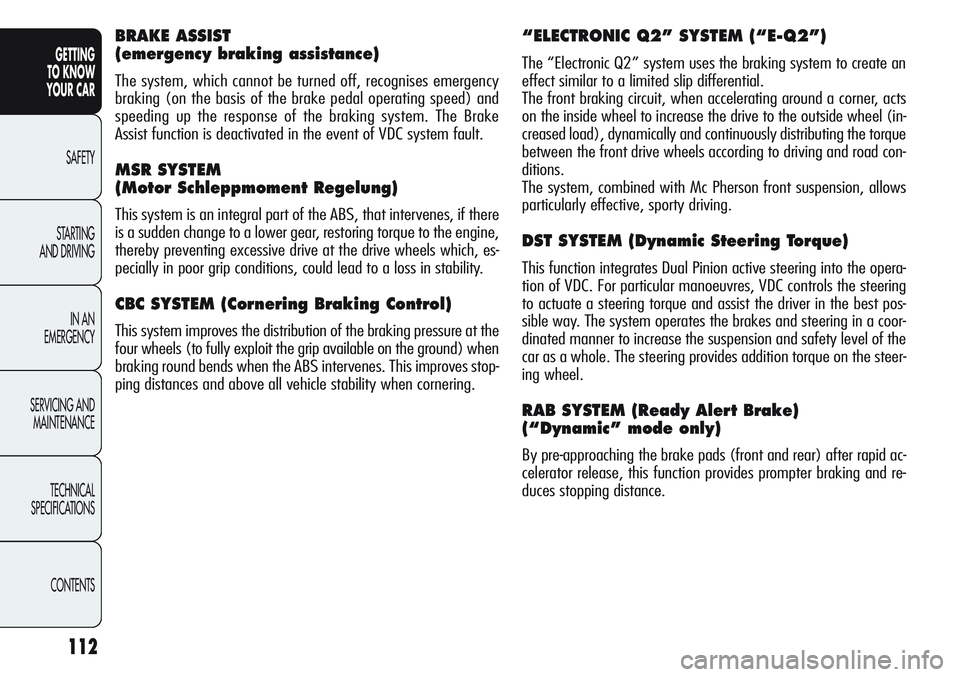
112
GETTING
TO KNOW
YOUR CAR
SAFETY
STARTING
AND DRIVING
IN AN
EMERGENCY
SERVICING AND
MAINTENANCE
TECHNICAL
SPECIFICATIONS
CONTENTS
“ELECTRONIC Q2” SYSTEM (“E-Q2”)
The “Electronic Q2” system uses the braking system to create an
effect similar to a limited slip differential.
The front braking circuit, when accelerating around a corner, acts
on the inside wheel to increase the drive to the outside wheel (in-
creased load), dynamically and continuously distributing the torque
between the front drive wheels according to driving and road con-
ditions.
The system, combined with Mc Pherson front suspension, allows
particularly effective, sporty driving.
DST SYSTEM (Dynamic Steering Torque)
This function integrates Dual Pinion active steering into the opera-
tion of VDC. For particular manoeuvres, VDC controls the steering
to actuate a steering torque and assist the driver in the best pos-
sible way. The system operates the brakes and steering in a coor-
dinated manner to increase the suspension and safety level of the
car as a whole. The steering provides addition torque on the steer-
ing wheel.
RAB SYSTEM (Ready Alert Brake)
(“Dynamic” mode only)
By pre-approaching the brake pads (front and rear) after rapid ac-
celerator release, this function provides prompter braking and re-
duces stopping distance.
BRAKE ASSIST
(emergency braking assistance)
The system, which cannot be turned off, recognises emergency
braking (on the basis of the brake pedal operating speed) and
speeding up the response of the braking system. The Brake
Assist function is deactivated in the event of VDC system fault.
MSR SYSTEM
(Motor Schleppmoment Regelung)
This system is an integral part of the ABS, that intervenes, if there
is a sudden change to a lower gear, restoring torque to the engine,
thereby preventing excessive drive at the drive wheels which, es-
pecially in poor grip conditions, could lead to a loss in stability.
CBC SYSTEM (Cornering Braking Control)
This system improves the distribution of the braking pressure at the
four wheels (to fully exploit the grip available on the ground) when
braking round bends when the ABS intervenes. This improves stop-
ping distances and above all vehicle stability when cornering.
Page 117 of 297
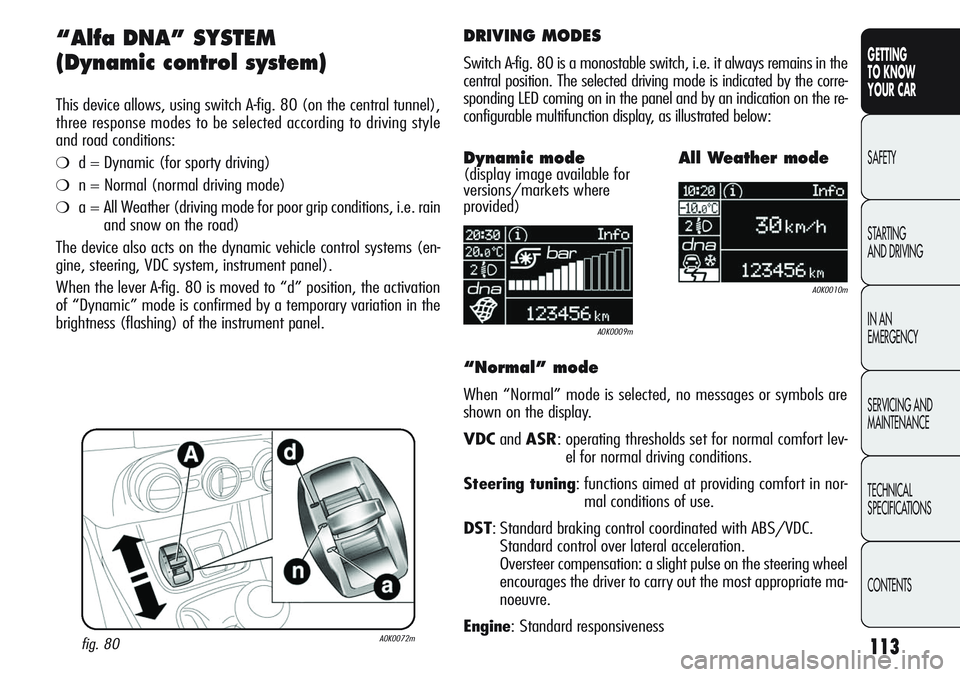
113
GETTING
TO KNOW
YOUR CAR
SAFETY
STARTING
AND DRIVING
IN AN
EMERGENCY
SERVICING AND
MAINTENANCE
TECHNICAL
SPECIFICATIONS
CONTENTS
“Alfa DNA” SYSTEM
(Dynamic control system)
This device allows, using switch A-fig. 80 (on the central tunnel),
three response modes to be selected according to driving style
and road conditions:
❍d = Dynamic (for sporty driving)
❍n = Normal (normal driving mode)
❍a = All Weather (driving mode for poor grip conditions, i.e. rain
and snow on the road)
The device also acts on the dynamic vehicle control systems (en-
gine, steering, VDC system, instrument panel).
When the lever A-fig. 80 is moved to “d” position, the activation
of “Dynamic” mode is confirmed by a temporary variation in the
brightness (flashing) of the instrument panel.
fig. 80A0K0072m
DRIVING MODES
Switch A-fig. 80 is a monostable switch, i.e. it always remains in the
central position. The selected driving mode is indicated by the corre-
sponding LED coming on in the panel and by an indication on the re-
configurable multifunction display, as illustrated below:
A0K0009m
A0K0010m
Dynamic mode (display image available for
versions/markets where
provided)All Weather mode
“Normal” mode
When “Normal” mode is selected, no messages or symbols are
shown on the display.
VDCandASR: operating thresholds set for normal comfort lev-
el for normal driving conditions.
Steering tuning: functions aimed at providing comfort in nor-
mal conditions of use.
DST: Standard braking control coordinated with ABS/VDC.
Standard control over lateral acceleration.
Oversteer compensation: a slight pulse on the steering wheel
encourages the driver to carry out the most appropriate ma-
noeuvre.
Engine: Standard responsiveness
Page 118 of 297
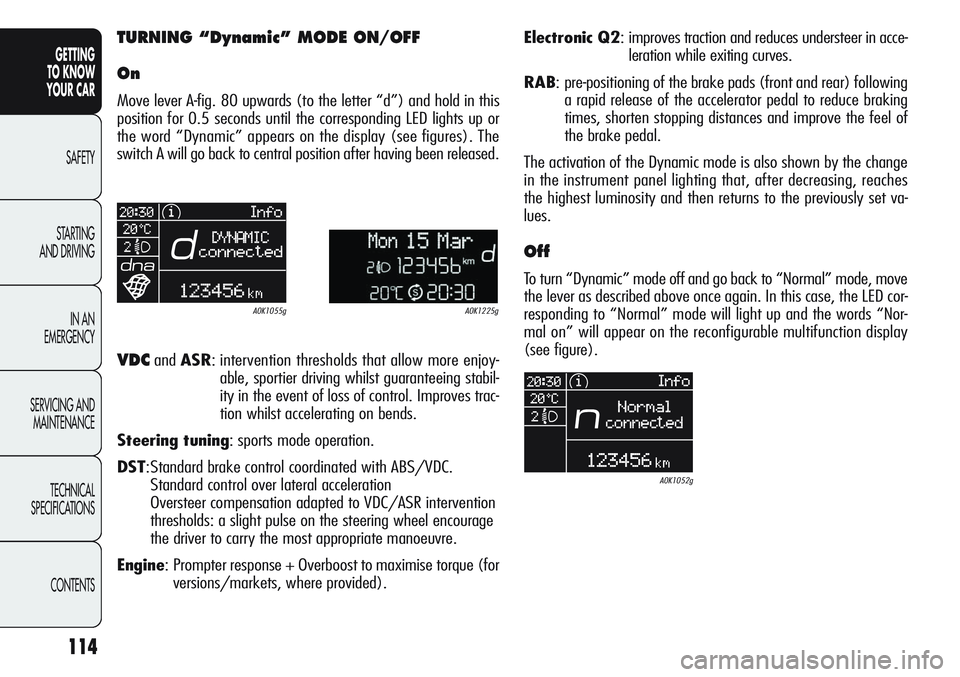
114
GETTING
TO KNOW
YOUR CAR
SAFETY
STARTING
AND DRIVING
IN AN
EMERGENCY
SERVICING AND
MAINTENANCE
TECHNICAL
SPECIFICATIONS
CONTENTS
TURNING “Dynamic” MODE ON/OFF
On
Move lever A-fig. 80 upwards (to the letter “d”) and hold in this
position for 0.5 seconds until the corresponding LED lights up or
the word “Dynamic” appears on the display (see figures). The
switch A will go back to central position after having been released.Electronic Q2: improves traction and reduces understeer in acce-
leration while exiting curves.
RAB: pre-positioning of the brake pads (front and rear) following
a rapid release of the accelerator pedal to reduce braking
times, shorten stopping distances and improve the feel of
the brake pedal.
The activation of the Dynamic mode is also shown by the change
in the instrument panel lighting that, after decreasing, reaches
the highest luminosity and then returns to the previously set va-
lues.
Off
To turn “Dynamic” mode off and go back to “Normal” mode, move
the lever as described above once again. In this case, the LED cor-
responding to “Normal” mode will light up and the words “Nor-
mal on” will appear on the reconfigurable multifunction display
(see figure).
A0K1225gA0K1055g
A0K1052g
VDCandASR: intervention thresholds that allow more enjoy-
able, sportier driving whilst guaranteeing stabil-
ity in the event of loss of control. Improves trac-
tion whilst accelerating on bends.
Steering tuning: sports mode operation.
DST:Standard brake control coordinated with ABS/VDC.
Standard control over lateral acceleration
Oversteer compensation adapted to VDC/ASR intervention
thresholds: a slight pulse on the steering wheel encourage
the driver to carry the most appropriate manoeuvre.
Engine: Prompter response + Overboost to maximise torque (for
versions/markets, where provided).
Page 119 of 297
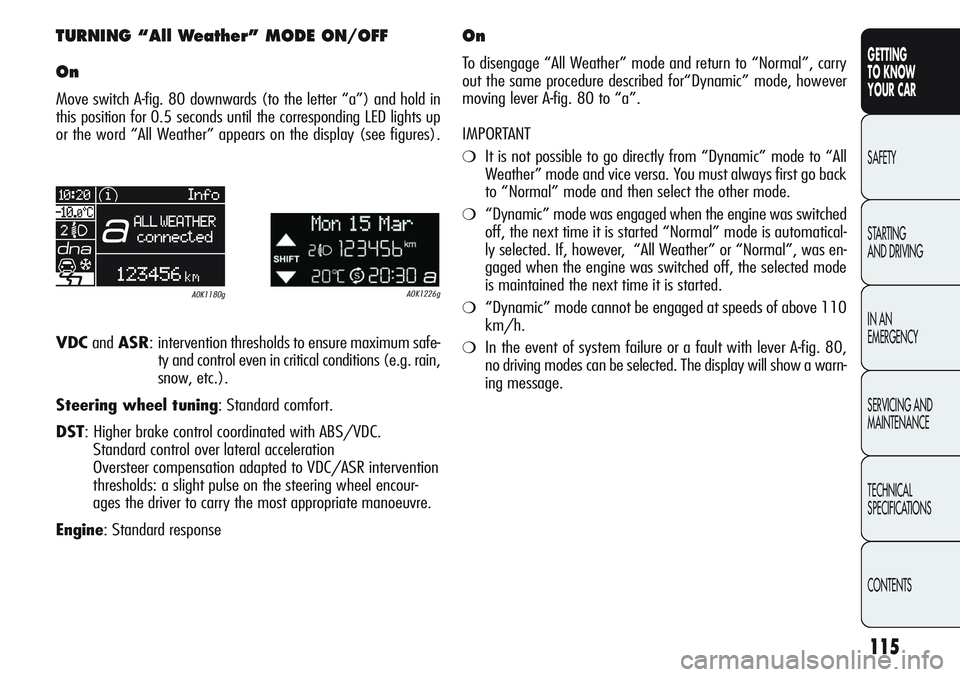
115
GETTING
TO KNOW
YOUR CAR
SAFETY
STARTING
AND DRIVING
IN AN
EMERGENCY
SERVICING AND
MAINTENANCE
TECHNICAL
SPECIFICATIONS
CONTENTS
TURNING “All Weather” MODE ON/OFF
On
Move switch A-fig. 80 downwards (to the letter “a”) and hold in
this position for 0.5 seconds until the corresponding LED lights up
or the word “All Weather” appears on the display (see figures).
A0K1226gA0K1180g
VDCandASR: intervention thresholds to ensure maximum safe-
ty and control even in critical conditions (e.g. rain,
snow, etc.).
Steering wheel tuning: Standard comfort.
DST: Higher brake control coordinated with ABS/VDC.
Standard control over lateral acceleration
Oversteer compensation adapted to VDC/ASR intervention
thresholds: a slight pulse on the steering wheel encour-
ages the driver to carry the most appropriate manoeuvre.
Engine: Standard response
On
To disengage “All Weather” mode and return to “Normal”, carry
out the same procedure described for“Dynamic” mode, however
moving lever A-fig. 80 to “a”.
IMPORTANT
❍It is not possible to go directly from “Dynamic” mode to “All
Weather” mode and vice versa. You must always first go back
to “Normal” mode and then select the other mode.
❍“Dynamic” mode was engaged when the engine was switched
off, the next time it is started “Normal” mode is automatical-
ly selected. If, however, “All Weather” or “Normal”, was en-
gaged when the engine was switched off, the selected mode
is maintained the next time it is started.
❍“Dynamic” mode cannot be engaged at speeds of above 110
km/h.
❍In the event of system failure or a fault with lever A-fig. 80,
no driving modes can be selected. The display will show a warn-
ing message.
Page 120 of 297
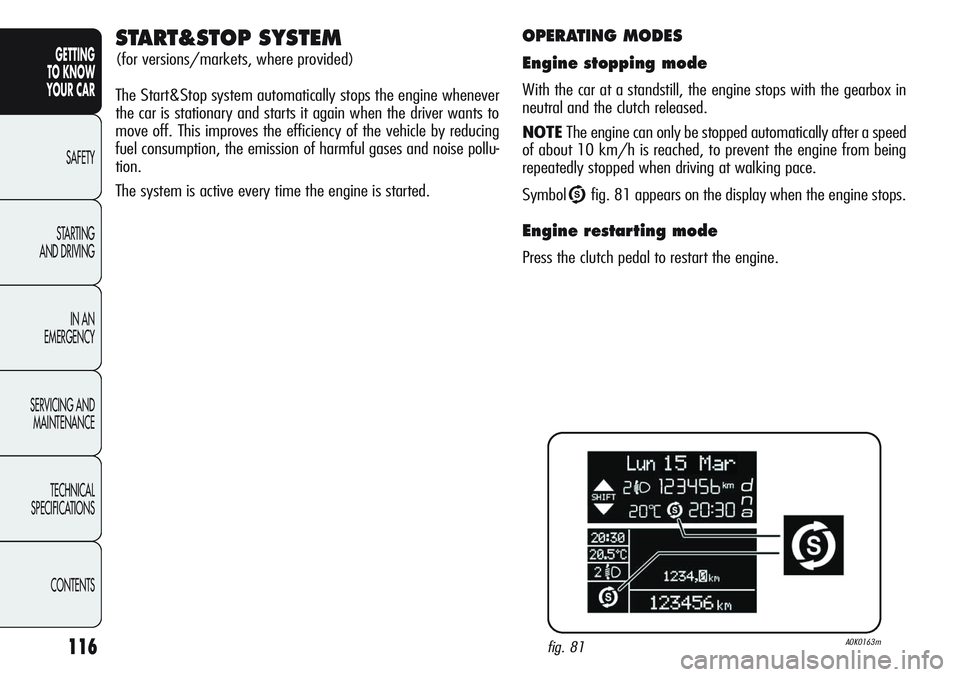
116
GETTING
TO KNOW
YOUR CAR
SAFETY
STARTING
AND DRIVING
IN AN
EMERGENCY
SERVICING AND
MAINTENANCE
TECHNICAL
SPECIFICATIONS
CONTENTS
OPERATING MODES
Engine stopping mode
With the car at a standstill, the engine stops with the gearbox in
neutral and the clutch released.
NOTEThe engine can only be stopped automatically after a speed
of about 10 km/h is reached, to prevent the engine from being
repeatedly stopped when driving at walking pace.
Symbol
Ufig. 81 appears on the display when the engine stops.
Engine restarting mode
Press the clutch pedal to restart the engine.
fig. 81A0K0163m
START&STOP SYSTEM
(for versions/markets, where provided)
The Start&Stop system automatically stops the engine whenever
the car is stationary and starts it again when the driver wants to
move off. This improves the efficiency of the vehicle by reducing
fuel consumption, the emission of harmful gases and noise pollu-
tion.
The system is active every time the engine is started.
Page 121 of 297
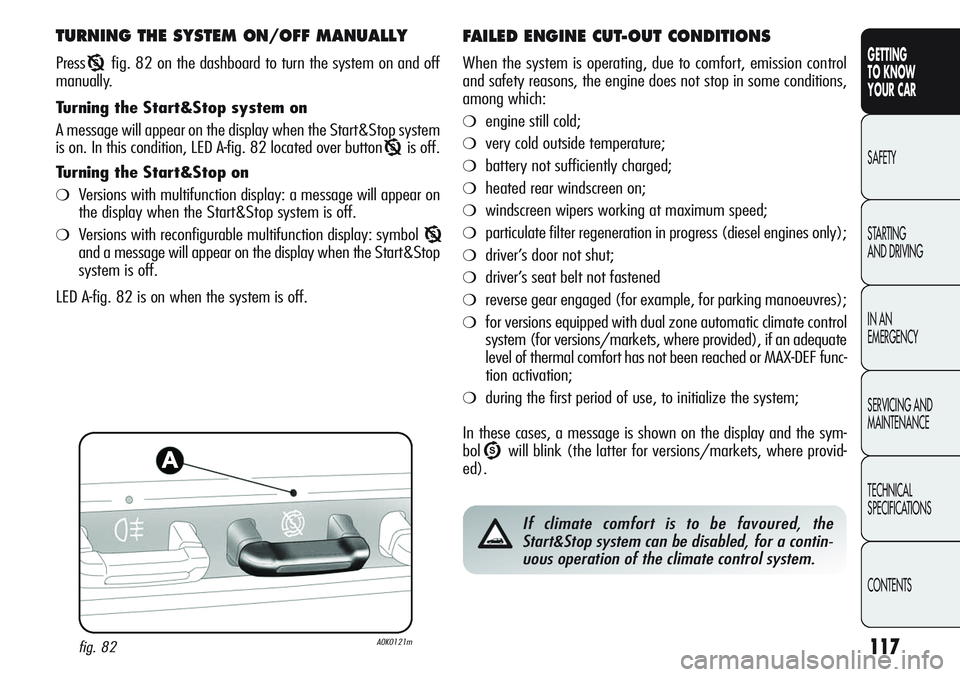
117
GETTING
TO KNOW
YOUR CAR
SAFETY
STARTING
AND DRIVING
IN AN
EMERGENCY
SERVICING AND
MAINTENANCE
TECHNICAL
SPECIFICATIONS
CONTENTS
TURNING THE SYSTEM ON/OFF MANUALLY
PressTfig. 82 on the dashboard to turn the system on and off
manually.
Turning the Start&Stop system on
A message will appear on the display when the Start&Stop system
is on. In this condition, LED A-fig. 82 located over button
Tis off.
Turning the Start&Stop on
❍Versions with multifunction display: a message will appear on
the display when the Start&Stop system is off.
❍Versions with reconfigurable multifunction display: symbol T
and a message will appear on the display when the Start&Stop
system is off.
LED A-fig. 82 is on when the system is off.
fig. 82A0K0121m
FAILED ENGINE CUT-OUT CONDITIONS
When the system is operating, due to comfort, emission control
and safety reasons, the engine does not stop in some conditions,
among which:
❍engine still cold;
❍very cold outside temperature;
❍battery not sufficiently charged;
❍heated rear windscreen on;
❍windscreen wipers working at maximum speed;
❍particulate filter regeneration in progress (diesel engines only);
❍driver’s door not shut;
❍driver’s seat belt not fastened
❍reverse gear engaged (for example, for parking manoeuvres);
❍for versions equipped with dual zone automatic climate control
system (for versions/markets, where provided), if an adequate
level of thermal comfort has not been reached or MAX-DEF func-
tion activation;
❍during the first period of use, to initialize the system;
In these cases, a message is shown on the display and the sym-
bol
Uwill blink (the latter for versions/markets, where provid-
ed).
If climate comfort is to be favoured, the
Start&Stop system can be disabled, for a contin-
uous operation of the climate control system.
Page 122 of 297

118
GETTING
TO KNOW
YOUR CAR
SAFETY
STARTING
AND DRIVING
IN AN
EMERGENCY
SERVICING AND
MAINTENANCE
TECHNICAL
SPECIFICATIONS
CONTENTS
Notes
If the clutch is not pressed, after 3 minutes from the engine stop-
ping, the engine can be restarted only using the ignition key.
In cases when the engine stops and this is not desired, due for
example to the clutch pedal being released sharply with a gear
engaged, if the Start&Stop system is activated, the engine can
be restarted by fully depressing the clutch pedal or by placing the
gear lever in neutral
RESTARTING CONDITIONS
For reasons of comfort, limiting harmful emissions and safety pur-
poses, the power unit can restart automatically without any action
on behalf of the driver if certain conditions are met, including:
❍battery not sufficiently charged;
❍windscreen wipers working at maximum speed;
❍low braking system vacuum, e.g. following the brake pedal be-
ing pressed repeatedly;
❍car in motion, for example when driving on hilly roads;
❍stopping the engine using Start&Stop longer than approxi-
mately 3 minutes;
❍for versions equipped with dual zone automatic climate control
system (for versions/markets, where provided), if an adequate
level of thermal comfort has not been reached or MAX-DEF func-
tion activation;
With gear engaged, the automatic engine restarting is possible on-
ly by fully pressing the clutch pedal. This operation is indicated to
the driver by means of a message on the display and by symbol
Ublinking (the latter for versions/markets, where provided).
Page 123 of 297

119
GETTING
TO KNOW
YOUR CAR
SAFETY
STARTING
AND DRIVING
IN AN
EMERGENCY
SERVICING AND
MAINTENANCE
TECHNICAL
SPECIFICATIONS
CONTENTS
SAFETY FUNCTIONS
When the engine is stopped by the Start&Stop system, if the dri-
ver releases his/her seat belt and opens the driver’s or passenger’s
door, the engine can be restarted only using the ignition key.
This condition is indicated to the driver by means of a buzzer and
by the symbol
Ublinking on the display (with a message, for
versions/markets, where provided).
ENERGY SAVING FUNCTION
(for versions/markets, where provided)
If, as a result of the engine automatic restarting, the driver does not
carry out any action on the vehicle for over 3 minutes, the Start&Stop
system stops the engine once and for all, to prevent fuel consump-
tion. In these cases, the engine can be restarted only using the ig-
nition key.
NOTEIn any case, it is possible to keep the engine running by de-
activating the Start&Stop system.
IRREGULAR OPERATION
In the event of malfunction, the Start&Stop system is deactivated.
The driver is informed of the fault by the flashing
Usymbol (ver-
sions with multifunction display) or
jsymbol (versions with re-
configurable multifunction display). For versions/markets, where
provided, a message is also displayed. In this case, contact
Alfa Romeo Authorized Services.
STORING THE CAR
In the case of storage, special care must be taken to disconnect the
battery electrical power supply.
Proceed as follows: detach the connector A-fig. 83 (by pressing but-
ton B) from sensor C for monitoring the status of the battery in-
stalled on the battery negative pole D. This sensor should never
be disconnected from the pole except if the battery is replaced.
fig. 83A0K0179m
In case of battery replacement, always contact
Alfa Romeo Authorized Services. Replace the bat-
tery using a new one of the same type (HEAVY
DUTY) and having the same specifications.
Page 124 of 297

120
GETTING
TO KNOW
YOUR CAR
SAFETY
STARTING
AND DRIVING
IN AN
EMERGENCY
SERVICING AND
MAINTENANCE
TECHNICAL
SPECIFICATIONS
CONTENTS
EMERGENCY STARTING
When jump starting, never connect the negative lead (–) of the
auxiliary battery to the negative pole A-fig. 84 of the car battery,
but rather to an engine/gearbox earth point.
Before opening the engine hood, make sure that
the engine is off and that the ignition key is in STOP
position. Follow the instructions on the plate af-
fixed on the front crossmember (fig. 85). You are advised
to extract the key when other people are inside the car.
Remove the ignition key or turn it to the STOP position be-
fore leaving the car. During refuelling, make sure that the
engine is off and the key is in STOP position.
fig. 84A0K0180mfig. 85A0K0224m
Page 125 of 297
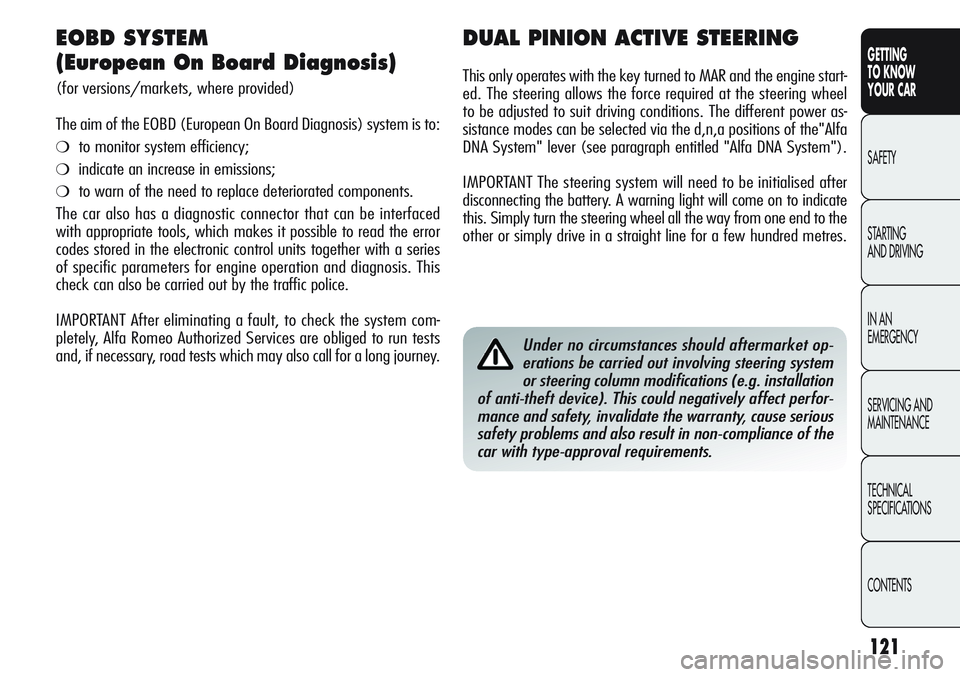
121
GETTING
TO KNOW
YOUR CAR
SAFETY
STARTING
AND DRIVING
IN AN
EMERGENCY
SERVICING AND
MAINTENANCE
TECHNICAL
SPECIFICATIONS
CONTENTS
EOBD SYSTEM
(European On Board Diagnosis)
(for versions/markets, where provided)
The aim of the EOBD (European On Board Diagnosis) system is to:
❍to monitor system efficiency;
❍indicate an increase in emissions;
❍to warn of the need to replace deteriorated components.
The car also has a diagnostic connector that can be interfaced
with appropriate tools, which makes it possible to read the error
codes stored in the electronic control units together with a series
of specific parameters for engine operation and diagnosis. This
check can also be carried out by the traffic police.
IMPORTANT After eliminating a fault, to check the system com-
pletely, Alfa Romeo Authorized Services are obliged to run tests
and, if necessary, road tests which may also call for a long journey.
DUAL PINION ACTIVE STEERING
This only operates with the key turned to MAR and the engine start-
ed. The steering allows the force required at the steering wheel
to be adjusted to suit driving conditions. The different power as-
sistance modes can be selected via the d,n,a positions of the"Alfa
DNA System" lever (see paragraph entitled "Alfa DNA System").
IMPORTANT The steering system will need to be initialised after
disconnecting the battery. A warning light will come on to indicate
this. Simply turn the steering wheel all the way from one end to the
other or simply drive in a straight line for a few hundred metres.
Under no circumstances should aftermarket op-
erations be carried out involving steering system
or steering column modifications (e.g. installation
of anti-theft device). This could negatively affect perfor-
mance and safety, invalidate the warranty, cause serious
safety problems and also result in non-compliance of the
car with type-approval requirements.